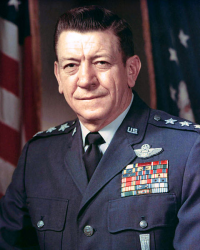
 |
|
|
||
|
Robert Ernest Huyser |
||||
|
Engagements: • World War II (1941 - 1945)• Korean War (1950 - 1953)• Vietnam War (1960 - 1973) |
||||
| Biography: | ||||
|
Robert Ernest Huyser General, U.S. Air Force Robert Ernest Huyser was born 14 June 1924 in Paonia, CO, where he graduated from Paonia High School. He later attended Modesto Junior College at Modesto, CA, and Ouachita College at Arkadelphia, AR. Military Service Huyser was drafted into the U.S. Army in April 1943 and in 1944 entered the aviation cadet program. In September 1944 he graduated from flying school and received his pilot wings and commission as a Second Lieutenant in the U.S. Army Air Forces. During World War II, he flew B-29 Superfortresses in the Southwest Pacific area. In May 1945 he was assigned as a B-29 pilot at Clovis, NM. From August 1946 to May 1947, Huyser was an Aircraft Commander in the 307th Bombardment Wing, MacDill Field, FL. He next became an Aircraft Commander in the 93rd Bombardment Wing at Castle AFB, CA, and in 1950 was assigned to the Wing staff as Chief of Training. During the Korean War, Huyser was assigned to the Far East Air Forces Bomber Command as Chief, Combat Operations. During that period he flew combat missions in B-29s with the 98th Bombardment Wing. He returned to the U.S. in September 1953 and was assigned as Chief, Combat Crew Section, Headquarters Fifteenth Air Force, March AFB, CA. In February 1957 he became chief, Training Division, for the 92nd Bombardment Wing, Fairchild AFB, WA, and later was named Director of Operations. Huyser returned to Headquarters Fifteenth Air Force in January 1959 as Assistant Chief and then as Chief, Combat Operations Branch. In July 1960 he became Chief, Operations Plans Division. He entered the Air War College at Maxwell AFB, AL, in August 1962. After his graduation in July 1963, he served as Chief, Concepts Branch, Operations Plans Division, Headquarters Strategic Air Command, Offutt AFB, NE. In July 1966 he assumed duties as Vice Commander of the 454th Bombardment Wing at Columbus AFB, MS, and in December 1966 he assumed Command of the 449th Bombardment Wing at Kincheloe AFB, MI. Huyser returned to Headquarters SAC in April 1968 and was assigned to the Office of the Deputy Chief of Staff, Operations, as Director, Command Control, and in February 1970 he assumed duties as Director of Operations Plans and Chief, Single Integrated Operational Plans Division, Joint Strategic Target Planning Staff. His principal involvement in the Vietnam War was administering the contingency war plans for SAC headquarters. He planned the B-52 missions, weaponeered the target boxes and executed the strikes. He also managed the SAC tanker support for the Southeast Asia area. He also flew B-52 combat missions over Vietnam and tanker support sorties out of Thailand. In June 1972, Huyser was assigned to Headquarters USAF in Washington, DC, in the Office of the Deputy Chief of Staff, Plans and Operations, as Director of Plans. In April 1973, he became Deputy Chief of Staff, Plans and Operations. He participated in the decision-making processes that resulted in C-130 Hercules resources being assigned to the Military Airlift Command and the designation of the Military Airlift Command as the Department of Defense's third specified command. On 1 September 1975, Huyser was promoted to the four-star rank of General and assigned as Deputy Commander-in-Chief of the U.S. European Command, Stuttgart-Vaihingen, Germany. In that position he was one of the major users of Military Airlift Command airlift support. In January 1979, while still EUCOM Deputy, President Jimmy Carter sent Huyser to Iran. Sources disagree on the nature of his mission. According to Carter, Huyser, and American sources, he attempted to stabilize Iran during the turbulent early stages of the Islamic revolution. Charles Kurzman describes him as having been assigned by Carter "to rally Iranian Military commanders and help them prepare for a last-resort coup d'etat," unaware that the massive scale of the uprising left the Iranian military powerless to prevent the Shah's overthrow. According to some supporters of the Shah, his goal was to destabilize the Shah's government. Shortly afterward, the Shah left Iran in exile and the Islamic Revolution took over the country. In his memoir Mission to Tehran, Huyser called the mission "one that started with desperation and disunity and ended in disaster," but praised the performance of U.S. personnel. General Huyser assumed Command of the Military Airlift Command in June 1979, his last posting. General Huyser retired from the Air Force on 1 July 1981. Medals and Awards Defense Distinguished Service Medal Air Force Distinguished Service Medal (2 Awards) Legion of Merit Bronze Star Medal Defense Meritorious Service Medal Air Medal Joint Service Commendation Medal Air Force Commendation Medal (3 Awards) Army Commendation Medal Presidential Unit Citation Air Force Outstanding Unit Award Small Arms Expert Marksmanship Republic of Korea Presidential Unit Citation General Huyser was a Command Pilot and flew more than 5,000 hours in SAC bombers, nearly 2,000 hours in SAC tankers, about 1,400 hours in single engine jet aircraft, and 1,500 hours in B-25, C-54, T-39 and various light aircraft. Death and Burial General Robert Ernest Huyser died 22 September 1997 at the David Grant Medical Center at Travis Air Force Base, CA. He is buried at Arlington National Cemetery in Arlington, VA. |
||||
| Honoree ID: 749 | Created by: MHOH | |||
Ribbons
Medals
Badges
Honoree Photos
 |  |  |
 |  |
 |


